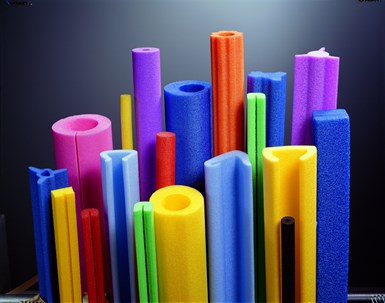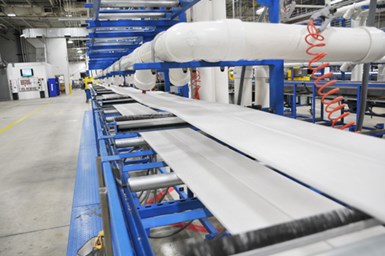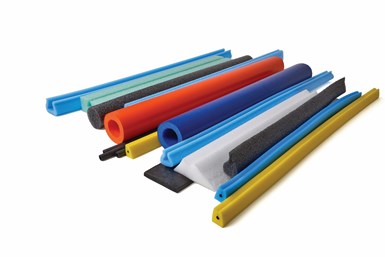Foam Processor Innovates on Path to Sustainability
Nomaco does foam and only foam, innovating solutions for consumers that not only solve problems but are better for the environment.
There are many paths toward sustainability, foaming among them. And one extrusion processor that’s been foaming sheet, profiles and tubing since its inception has continued to use its expertise to develop more sustainable products that usually replace heavier materials.
Based in a two-plant campus in Zebulon, N.C., Nomaco was founded in 1979 by Marc Noël, who emigrated from Belgium with an idea to produce foamed PP to insulate copper pipe. Undeterred by research that concluded there was no market in the U.S. for such a product, Noël created one. “And that still drives us today,” says JP Hill, CEO of Noël Group, a holding company under which Nomaco operates. “Our mission is to create something that’s never been done before, generate next-generation, disruptive products based on recyclability, lightweighting while creating a much longer life cycle for those products.”
Nomaco sold the pipe-insulation business once, as Hill says, “it became commoditized.” But innovation continued. Working with twin-screw compounding extrusion specialist Leistritz, the company developed a process to produce the first synthetic (a PP-based coextrusion) wine cork called Normacorc. Normacorc was eventually spun out as a separate company and today is part of closure company Vinventions, which is also under the Noël Group umbrella. Nomaco has engineered novel foamed profiles for home furnishings; was instrumental in the creation and development of foam extrusions used as water toys and exercise/wellness products; and worked with a leading mattress supplier on a foam solution that made it unnecessary for users to flip the mattress.

Nomaco makes a range of PE- and PP-based foamed tubes and profiles for applications that include construction, flotation, impact protection and more. Photos: Nomaco
In building and construction, Nomaco’s product line includes materials that are used as concrete forms, or as fillers for concrete expansion and contraction joints almost anywhere concrete is used, including driveways, sidewalks, bridges and runways. These applications have traditionally been held by asphalt-impregnated fiberboard. Nomaco gasket foam products are used as a moisture and air infiltration barrier for marriage walls on modular and log homes. These joint filler and gasket products are made from extruded PE and PP materials open-cell, closed-cell and bi-cellular foams.
In 2017, a product trade named Nomaflex was named as one of the 2017 Most Innovative Products at World of Concrete. This is a closed-cell extruded PE foam joint filler which is easy to handle and extends the service life of concrete by acting as an insulator for contraction and expansion joints.
Says Bryan Bunker, Nomaco president, “We want to be innovators and let the market tell us where our foam can be best utilized. That’s why we are active in some many different markets.” Sometimes employees on the production floor help drive this process. Bunker recalls one such instance, “We had an employee ask if he could take home some scrapped sheet. We said yes and asked what he was thinking. He replied that he’d use them to make his own hurricane shutters. He said they were easier to install than plywood and just as effective. Now this is becoming a commercial product.”
“We want to be innovators and let the market tell us where our foam can be best utilized.”
Adds Hill, “ Customers generally find us because they have an idea for a foam applications. Over the years we have demonstrated time and again that we can not only do new and novel things but can take these ideas to the commercial level. Customers may have done small-scale test work, then come to us to see if we can turn it into something better. This might require reformulation of the material or different tooling. Partnerships are formed based on our foaming know-how, and they evolve quickly because of our ability to commercialize.”
Hill continues: “We tend to be the innovation partner of choice because of the scale we have. And that gives us the ability to work with Fortune 500 companies. We work with them on early stages of technology, and when it comes time to scale we also have capabilities for much higher throughput.”
Processing Firepower
Nomaco has two plants at a 90-acre campus in Zebulon, where 220 are employed. A 275,000 ft2 facility is used mainly for warehousing. A just-completed expansion of its main manufacturing facility increased its footprint from 65,000 to 125,000 ft2. Between the two plants, Nomaco runs 13 single- and twin-screw compounding lines, foaming PE, PP, EVA copolymers and other materials, notes Bunker. Flat PP foamed sheet is extruded in thickness down to 4 mm; PE-based foam sheet runs in thicknesses from ½-in. to 3-in. and up. Profile shapes are customized depending on that application.

Nomacor utilizes single- and twin-screw extruders to produce profiles and sheet, with downstream machinery built in-house.
On the die and tooling side, Nomaco uses advanced 3D computer modeling and more than 100 years of tribal knowledge to design everything in-house, utilizing state-of-the-art machine tools that hold tolerances to ±0.00001 in. Downstream of the extruder, Nomaco uses a handful of homemade machines for conveying and handling the extrusions, many of which are welded to form the final product. Nomaco used blowing agents for foaming, though certain other elements of its process are proprietary.
And foaming is but one of the roads Nomaco takes in the direction of sustainability. Its philosophy for Environmental Stewardship is based around the 3 Rs of Reduce, Reuse and Recycle. In the real world, this includes partnering with its customers to develop solutions that minimize material usage; eliminating pallets from virtually all products to minimize unnecessary packaging; recycling 95% of production scrap; processed foam for re-use in other products; recycling 100% of its used corrugated containers; utilizing up to 100% recycled material in certain products, depending on product and application; and offering biodegradable PE foam products.
Nomaco’s philosophy for Environmental Stewardship is based around the 3 Rs of Reduce, Reuse and Recycle.
Says Bunker, “We take a proactive approach and use additives so that when or if the time comes and our products are in a biologically active landfill, they will break down and not create any microplastic and be consumed by the microbes within those landfills.”
On the business side, Hill says that many of Nomaco projects start out as single projects then expand once the customer learns of the company’s capabilities. “Quite often, if we can get in with a small opportunity, we’re confident we can expand offerings to that particular customer. Once we bring someone into the (meeting rooms), they are exposed to all of our capabilities and applications. And usually that leads to more projects.”
Other projects happen, well, just because. Says Hill, “During Covid we got a message from our virtual receptionist that an engineer from Ford called because they wanted a foamed profile. Our first thought is that this was a mistake, but we called him back anyway.”

Regardless of shape or complexity, all extrusion dies and tooling used by Nomaco are designed and fabricated in-house.
Agility Comes into Play
“Turns out we have developed a reputation of being easy to work with and agile. Ford wanted a foam for face shields. They were using a PUR foam that was absorbing moisture and bacteria,” Hill says. “So, they laid down the challenge for us to create a foam that could replace PUR at a reasonable cost and could be cleaned easily, not absorb bacteria. It amazed me to see how quickly we were able to collaborate.
“Within five weeks we were able to develop five profile designs and what ended up as the one had an hourglass shape that had an internal diameter. They had a foam selected before they had the equipment in place to automate the production of the face shield. That’s one example of how we bring all of our foaming expertise to the table to solve problems.”
Related Content
Why Compression Ratio is Important
Compression ratios have been pretty much standardized over the years, based on what has typically worked before. But there are quite a few variables that must be considered in order to get the optimum performance from your screw.
Read MoreThe Importance of Barrel Heat and Melt Temperature
Barrel temperature may impact melting in the case of very small extruders running very slowly. Otherwise, melting is mainly the result of shear heating of the polymer.
Read MoreTroubleshooting Screw and Barrel Wear in Extrusion
Extruder screws and barrels will wear over time. If you are seeing a reduction in specific rate and higher discharge temperatures, wear is the likely culprit.
Read MoreCooling the Feed Throat and Screw: How Much Water Do You Need?
It’s one of the biggest quandaries in extrusion, as there is little or nothing published to give operators some guidance. So let’s try to shed some light on this trial-and-error process.
Read MoreRead Next
Processor Turns to AI to Help Keep Machines Humming
At captive processor McConkey, a new generation of artificial intelligence models, highlighted by ChatGPT, is helping it wade through the shortage of skilled labor and keep its production lines churning out good parts.
Read MorePeople 4.0 – How to Get Buy-In from Your Staff for Industry 4.0 Systems
Implementing a production monitoring system as the foundation of a ‘smart factory’ is about integrating people with new technology as much as it is about integrating machines and computers. Here are tips from a company that has gone through the process.
Read MoreAdvanced Recycling: Beyond Pyrolysis
Consumer-product brand owners increasingly see advanced chemical recycling as a necessary complement to mechanical recycling if they are to meet ambitious goals for a circular economy in the next decade. Dozens of technology providers are developing new technologies to overcome the limitations of existing pyrolysis methods and to commercialize various alternative approaches to chemical recycling of plastics.
Read More











.png;maxWidth=300;quality=90)

















